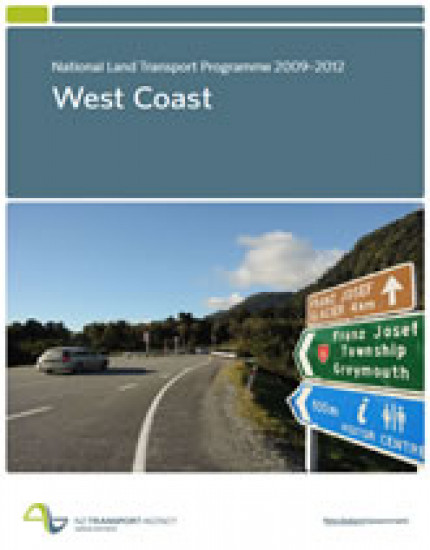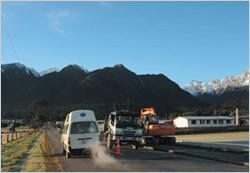Links to other regions are crucial to the economy of the West Coast region. Closures of these routes can cause major delays for locals, tourists and freight traffic, which can have significant negative effects on the region’s economy. The reliability, capacity, safety and security of the routes on which the region depends is therefore a major focus of this NLTP, which allocates funding to maintain the region’s local and state highway networks to support economic growth in our region.


I'm pleased to introduce to you this National Land Transport Programme (NLTP) for 2009-2012 – a programme through which the NZ Transport Agency (NZTA) is making a record investment in land transport at a time when New Zealand needs it most.
The global economic situation has changed dramatically in the past 18 months, with significant effects for the New Zealand economy. In response, and as part of its commitment to improving New Zealand's economic outlook and performance, the government has set clear expectations and priorities for the land transport sector. These expectations are articulated in the Government policy statement on land transport funding 2009/10 – 2018/19 (GPS)(external link).
Through this NLTP, the NZTA 'gives effect' to the GPS with a focus on supporting economic activity and employment throughout the country. It aims to deliver the best possible returns for New Zealand, through prioritising a wide range of national and regional activities.
The NLTP demonstrates an increased focus on efficiency and effectiveness in all spending, a rigorous national approach to setting priorities, and an ongoing focus on improving safety and reducing the adverse environmental effects of land transport. Inevitably there is a greater investment in some areas over others where these expectations are clearly met.
This document details the funding provided for the West Coast region – and as a dynamic document will be reviewed and updated regularly to reflect any approved variations to programmes.
For information on funding for the rest of New Zealand (and how the NLTP is developed and managed) please see the national NLTP document.
Links to other regions are crucial to the economy of the West Coast region.

Closures of these routes can cause major delays for locals, tourists and freight traffic, which can have significant negative effects on the region's economy. The reliability, capacity, safety and security of the routes on which the region depends is therefore a major focus of this NLTP, which allocates funding to maintain the region's local and state highway networks to support economic growth in our region.
Another challenge is ensuring our local roads and state highways cope with the region's increasing growth in mining, dairy and tourism. Road safety remains a particular concern, especially around the potential conflict between heavy and light vehicle traffic on single-lane bridges and narrow, winding sections of road (compounded by a lack of passing opportunities). The number of single-lane bridges on state highways also poses a road safety risk and affects traffic flow.
A National Bridge Replacement Study aims to address these issues. This has identified the need to replace the Goat Creek Bridge on State Highway (SH) 73.
In summary, the West Coast's transport priorities to which this NLTP responds are:
A strong commitment to value for money has led to changes in how R (regionally distributed) funding is used. R funding will be used for the highest-priority projects in this NLTP, providing a guaranteed minimum level of funding for West Coast. R funding comes from a portion of fuel excise duty and light road user charges and is allocated proportionally to regions based on population.
In the past, R funding was used to fund lower-priority projects that would otherwise not qualify for funding. The new approach delivers much greater value for money for all public money invested in land transport.
This NLTP provides an investment of $110.8 million for the West Coast region over the 2009-2012 period. I'm confident that this NLTP gives the required effect to the GPS. All funds have been allocated to activity classes within the GPS limits and in line with the NZTA's priorities.
In the next three years activities that are likely to be funded include:
For an overview of all projects in the region likely to receive funding in the next three years, see the regional map.
The National Land Transport Fund can only be used to fund activities listed in the NLTP. The tables in this NLTP list:
In the past 12 months, we've achieved a number of NLTP milestones in making our region's roads safer, more resilient and more suitable for the people and businesses that use them every day.
These include:
The West Coast Regional Transport Committee has a pivotal role in shaping the region's transport future.
The committee comprises elected members from the regional and local authorities on the West Coast, a representative from the NZTA and six community representatives with expertise in areas such as access and mobility, safety and personal security, and economic development.
One of the committee's key tasks is to develop the West Coast's three-year RLTP, which prioritises the regional transport activities proposed by the NZTA, transport activities for the Department of Conservation and capital improvements for the regional and local authorities that are more than 'minor' works.
This regional perspective enabled the NZTA to build a geographic view of land transport requirements nationwide, and to align regional and national views in deciding on the most appropriate allocations of funds to give effect to the GPS. Public submissions on the West Coast's draft programme were reflected in the final programme that went to the NZTA Board, which made the ultimate funding decisions for the NLTP.
I believe this NLTP augurs well for the West Coast's future as a key contributor to New Zealand's social and economic wellbeing. I look forward to working closely with our regional and local authority partners, New Zealand Police and the West Coast community on ensuring it is implemented successfully.
Mark Yaxley
Regional Director
Last updated: 6 October 2009